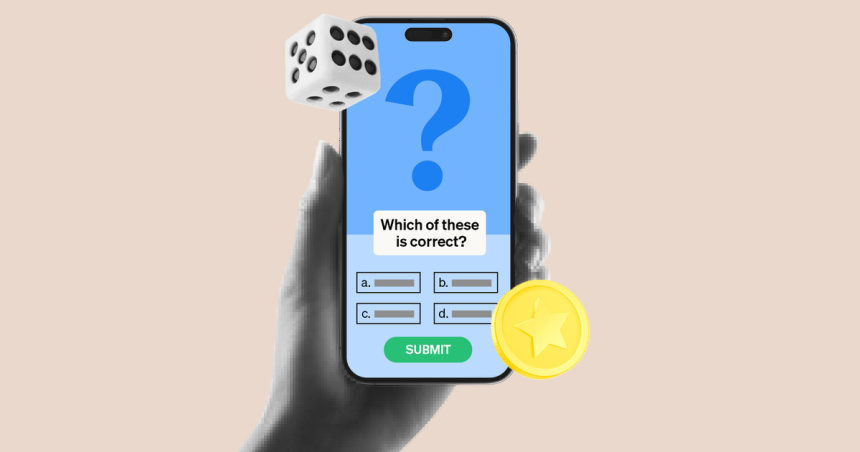Everyone is playing games these days. No, we’re not talking about your dating life. We’re talking about major brands looking for ways to incorporate gaming into their advertising products.
Take Disney, which recently rolled out two new “advergames” on Hulu and ESPN called Quiz Show and Beat the Clock. Quiz Show offers brands the chance to give viewers a short trivia game on screen, while Beat the Clock incorporates a brand’s identity into rapid-fire games. Brands have already shown some interest. Topgolf was the first to take advantage of the Beat the Clock ad format in an experience where viewers were able to practice golf using their TV remotes.
The gamified ad formats, which are also being embraced by companies like Amazon and Discord, represent a bid to engage users while making the experience of watching ads potentially a little less tedious.
“Ads are very prominent now, so it’s really hard to break through and feel personalized to each customer,” Carli Jurczynski, associate VP and paid media client lead at the agency Kepler, said. “Something that feels new and interactive, especially in the TV space, is something that’s really appetizing to our clients.”
GG, noob
In May, Amazon, which introduced an ad-supported version of Prime Video a few months before, announced a new ad format for marketers: interactive brand trivia ads. The ads are meant to incorporate brand facts into a quiz-like game, during which users have the option to request more information from the brand via email, add products to their chart, and obtain rewards like Amazon shopping credits.
Ahead of Prime Day, which saw record sales this year, Kepler shared details about Amazon’s trivia ad format and other interactive ad formats available from the e-commerce giant in a company blog post, and Jurczynski told us that the firm advised clients on Prime Day strategies.
“A huge roster of our clients under Hasbro and a lot of our retail clients [like] Shark Ninja were huge sellers on Amazon, and we were using a lot of their interactive products,” Jurczynski said, adding that while those clients weren’t necessarily taking advantage of CTV ads, biddable, search, and shopping formats were a major focus. “We were very much leaned in on Prime Day.”
The possibility of inserting game-like experiences into ads has brought in some companies that have historically been resistant to advertising to try the format out.
Discord, whose co-founder and CEO Jason Citron told the Wall Street Journal in 2021 that the platform wasn’t interested in monetizing through ads, rolled out “sponsored quests” widely in April, the first of which was made available to players of the combat game The Finals. The format, which is targeted toward game developers, allows users who stream on Discord and play games that contain sponsored quests the chance to earn rewards. Users who are watching the stream can also join the game and complete the quest themselves and earn rewards.
The communication platform first tested sponsored quests last year, including a “May the 4th” Fortnite quest run in partnership with Epic Films and Lucasfilm Games. Now, sponsored quests are more widely available to game developers, Peter Sellis, who runs Discord’s product org, announced in a company blog post in March.
Carly A. Kocurek, a professor of digital humanities and media studies at the Illinois Institute of Technology, said that gaming has long been a part of the marketing and advertising world: just think of word searches and puzzles on the backs of cereal boxes, collectible items, or even loyalty programs, which can be gamified.
“Advertising in general is always very smart as an industry about responding to and engaging with new media technologies and the cultural zeitgeist,” Kocurek said, adding that “video games now, compared to even five or 10 years ago, are really seen as a normal part of daily life…Increasingly, it’s not seen as distinct or novel that someone plays video games, because everyone plays video games.”
Two can play at that game
It’s no secret that games can help boost user engagement, and companies are getting into gaming beyond just planting them in ads. Earlier this summer, Warner Bros. Discovery acquired Player First Games, a studio it partnered with on MultiVersus, a free-to-play game released in May that features numerous WBD characters like the Joker and the Iron Giant.
At a Morgan Stanley event earlier this year, WBD CEO and President of Global Streaming and Games JB Perrette emphasized on the company’s increased focus on live-service, mobile, and free-to-play games (even though video games can sometimes be a costly bet: WBD reported a $200 million loss on 2023’s commercial and critical flop Suicide Squad: Kill the Justice League).
Streaming competitor Netflix has also leaned into mobile games, adding games including Minesweeper and Cozy Grove: Camp Spirit to its mobile app. Netflix’s investment in games seems likely to continue: Netflix games boss Mike Verdu recently shifted over to a new role in the streamer’s gaming division focused on “new technologies,” he told GamesIndustry.biz in June.
Overall, consumer spending on mobile games broke $20 billion this year, the first time it’s happened in two years, according to a Sensor Tower report released earlier this year, and the mobile game Monopoly Go made more than $770 million in the first quarter of 2024, Sensor Tower reported, the most a mobile game has ever made in one quarter.
“The strong bounce back on mobile has only accelerated as we enter 2024, with economic and regulatory headwinds fading further into the past,” the report’s authors wrote.
Get marketing news you’ll actually want to read. Subscribe to Marketing Brew today.
Read the full article here










